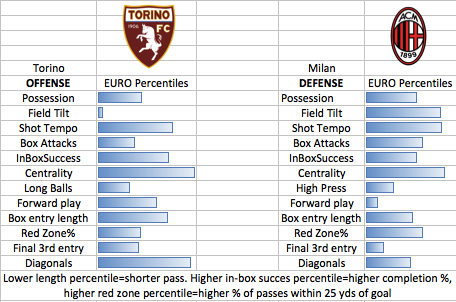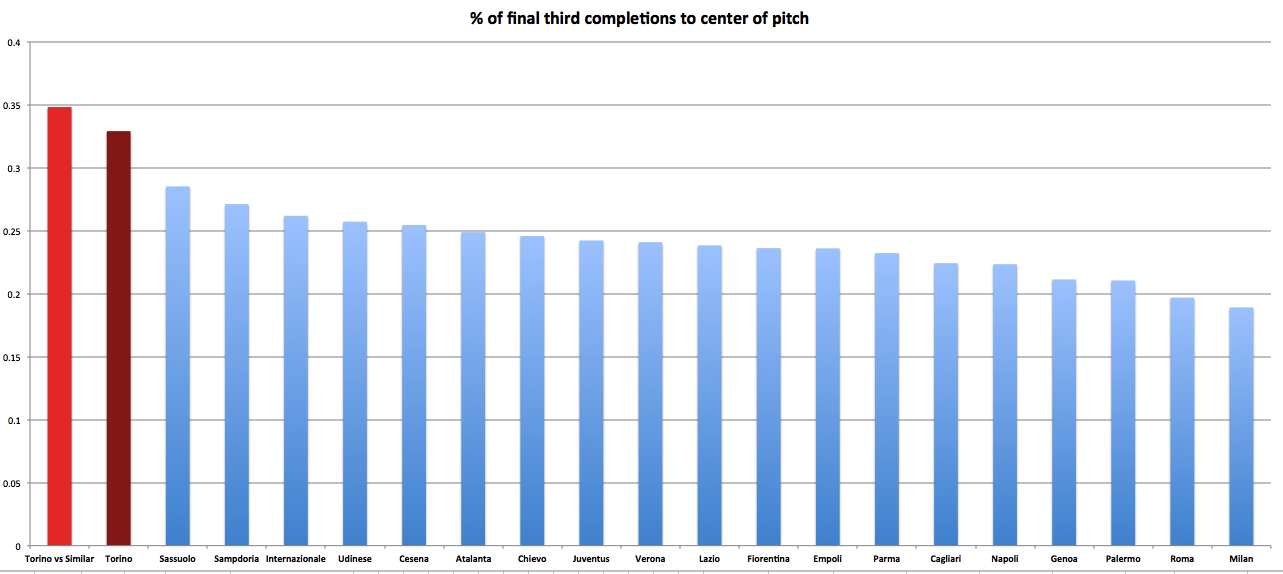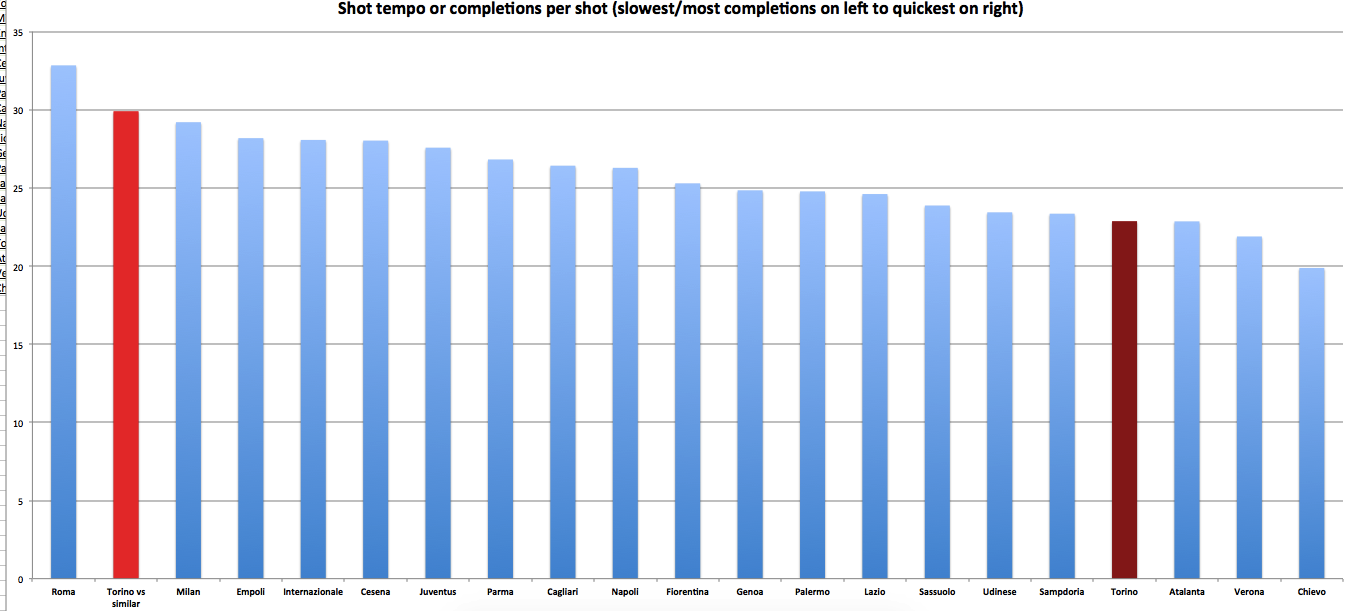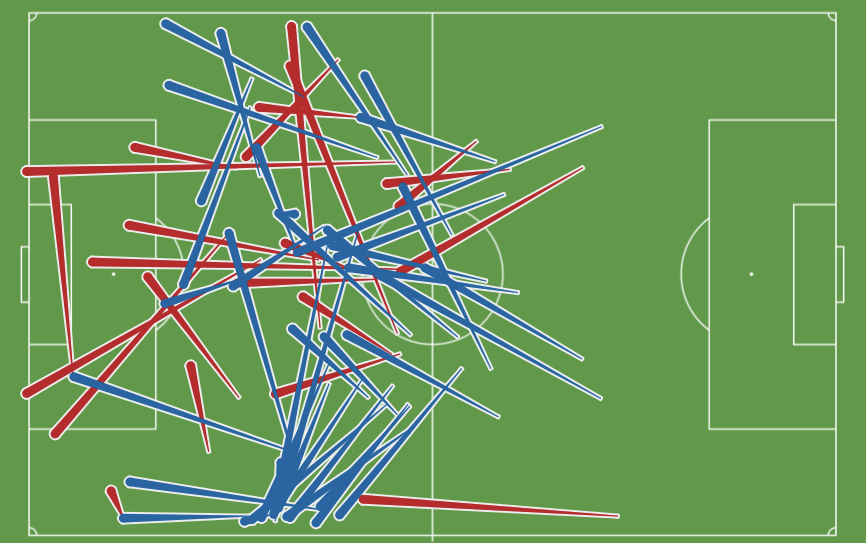 I've often heard soccer described as a data thin sport, a sport where the lack of big events holds back analysis. While that's true with regards to shots, saves, expected goals and goals, it's far from true for the rest of the game. Everywhere else, it is an extremely data-rich game because of how many actions each player makes. One single match can tell you more about a player in soccer than it does in most any other sport due to this high number of actions, we just haven't quite made all that data accessible yet. This post will be diving into the granularity of a single half looking at only one side of the ball and attempting to use some of this data to help our team get an edge. The goal is not to analyze one Milan-Torino match and be done, but to hopefully illuminate how stats and analysis can be of great help to teams on a time-frame of minutes and days not just months and years. Before any of this analysis becomes useful for a team, analysts at clubs have to have good relationships with the coaching staff and players. They could be creating impeccable game plans but if it's dry, technical and they have no relationship with the playing staff it will not get implemented. The Pittsburgh Pirates found real success at blending analytics onto the field by having a analytics staffer travel with the team, sit in on every pre-game meeting with the coaching staff, and spend more time in the clubhouse. This led to great two-way communication where experienced baseball coaches could get to know the analytics staff and begin to trust them more and players and staff could ask questions and led the analysts to places that would never have occurred to them without this interaction. This relationship often means presenting your findings in a different way than you might at an academic conference:
I've often heard soccer described as a data thin sport, a sport where the lack of big events holds back analysis. While that's true with regards to shots, saves, expected goals and goals, it's far from true for the rest of the game. Everywhere else, it is an extremely data-rich game because of how many actions each player makes. One single match can tell you more about a player in soccer than it does in most any other sport due to this high number of actions, we just haven't quite made all that data accessible yet. This post will be diving into the granularity of a single half looking at only one side of the ball and attempting to use some of this data to help our team get an edge. The goal is not to analyze one Milan-Torino match and be done, but to hopefully illuminate how stats and analysis can be of great help to teams on a time-frame of minutes and days not just months and years. Before any of this analysis becomes useful for a team, analysts at clubs have to have good relationships with the coaching staff and players. They could be creating impeccable game plans but if it's dry, technical and they have no relationship with the playing staff it will not get implemented. The Pittsburgh Pirates found real success at blending analytics onto the field by having a analytics staffer travel with the team, sit in on every pre-game meeting with the coaching staff, and spend more time in the clubhouse. This led to great two-way communication where experienced baseball coaches could get to know the analytics staff and begin to trust them more and players and staff could ask questions and led the analysts to places that would never have occurred to them without this interaction. This relationship often means presenting your findings in a different way than you might at an academic conference:
"They had to democratize the data and turn it into something that not only stat wonks understood, but athletes, too. Fox and Fitzgerald knew they might lose players if they just passed along numerical data. They had learned in their limited conversations with players that they absorbed visual materials amazingly fast and retained the information."
-from the recommended book Big Data Baseball. The need for communication is key in soccer as well. Carles Planchart is Bayern's head analyst and he puts it this way: "The most efficient method is to show them visual images, because that gets the idea across very quickly." Planchart discussed his and Pep's halftime routine in the book Pep Confidential:
"He usually picks three or four concepts to cover at half-time and will use two or three three-second videos to demonstrate what he means about each one. In total, there will be rapid shots of roughly 10 specific moves. ‘What are we doing at half-time? That’ll be Pep’s first question. He comes into his office and asks, “what are you seeing up there?” Because you get a completely different view of the action from up above and you spot different things. He always listens attentively when I make my report."
For soccer analysts at a club, detailed single-match work like this is where most of your time and impact should be. Even turning 2% of losses into draws and 2% of draws into wins could make a big difference in the table and the clubs finances in a way that I don't think is as easy to do through analysis in the transfer market at this point. In this example I am hypothetically working as one of the defensive analysts for AC Milan as we prepare for our match against Torino in Serie A. I say "one of the defensive analysts" because any large team should have way more staff than they do now. The Pirates have 7 people on an analytics staff with revenues of $229 million, according to Forbes. AC Milan have revenues of $339 million and play in a sport that is probably 25 times harder to analyze and 25 years behind in terms of the statistical work done. If the Pirates can hire 5 full-time guys and 2 part-timers just for analytics, there’s no reason AC Milan can’t have a dozen analysts working for them. Anyway, for this piece I’m imagining I am one of those guys.  Build-Up While some of my partners review our previous match, it falls to me to prepare a basic scouting report on the upcoming attack. I start with a Style Profile featuring their offense and our defense:
Build-Up While some of my partners review our previous match, it falls to me to prepare a basic scouting report on the upcoming attack. I start with a Style Profile featuring their offense and our defense:  The two main characteristics our coaches need to know are they are off the charts at playing centrally in the final third and playing deep in their own half. They can then decide if they want to press high to attempt to kickstart the offense or sit back and avoid being stretched as Torino coach Giampiero Ventura always tries to do (quote from his thesis: "possession of the ball aims to attract the opposing players in one area of the field to take advantage of the spaces that are created in other areas"). Next up, we want to see how Torino plays against teams similar to our defense. We know from our previous analysis on similarity scores that our defense plays similarly to Atalanta, Sampdoria, and Verona and is closely related to Cagliaro, Chievo, and Palermo. Stuffing down our disgust that mighty AC Milan is grouped in with these teams, we do some analysis on how Torino approached those teams, especially when playing away. We see they pass even deeper in their own half (vertical line represents about midfield)
The two main characteristics our coaches need to know are they are off the charts at playing centrally in the final third and playing deep in their own half. They can then decide if they want to press high to attempt to kickstart the offense or sit back and avoid being stretched as Torino coach Giampiero Ventura always tries to do (quote from his thesis: "possession of the ball aims to attract the opposing players in one area of the field to take advantage of the spaces that are created in other areas"). Next up, we want to see how Torino plays against teams similar to our defense. We know from our previous analysis on similarity scores that our defense plays similarly to Atalanta, Sampdoria, and Verona and is closely related to Cagliaro, Chievo, and Palermo. Stuffing down our disgust that mighty AC Milan is grouped in with these teams, we do some analysis on how Torino approached those teams, especially when playing away. We see they pass even deeper in their own half (vertical line represents about midfield)  and pass even more centrally
and pass even more centrally  This just drives home the point that we need a coherent plan on how we will try to defend their build-up play. Our deepest midfielders can be used to force play wide or to try and break up the moves by pushing higher with our attackers. We aren't an accomplished pressing team so this might be given high priority in training. We want to make teams go away from what they want to do. The major differences vs similar defenses: lower shot tempo, longer passes into the box, and lower share of their passes in the "red zone" (within 25 yards of the opposing goal).
This just drives home the point that we need a coherent plan on how we will try to defend their build-up play. Our deepest midfielders can be used to force play wide or to try and break up the moves by pushing higher with our attackers. We aren't an accomplished pressing team so this might be given high priority in training. We want to make teams go away from what they want to do. The major differences vs similar defenses: lower shot tempo, longer passes into the box, and lower share of their passes in the "red zone" (within 25 yards of the opposing goal).
 From this we start to suspect they won't flood the box with numbers. They will pick their spots to attack and will use Omar El Kaddouri to spearhead them. Against Chievo in their last game, El Kaddouri completed 18 passes to their two forwards, all of them coming in the center of the pitch. No other player completed more than 9 passes to forwards and they only completed 1 pass between themselves. Here is an example of where he was feeding the forwards
From this we start to suspect they won't flood the box with numbers. They will pick their spots to attack and will use Omar El Kaddouri to spearhead them. Against Chievo in their last game, El Kaddouri completed 18 passes to their two forwards, all of them coming in the center of the pitch. No other player completed more than 9 passes to forwards and they only completed 1 pass between themselves. Here is an example of where he was feeding the forwards  and here is how he was supplied, map via analyst Tom Worville
and here is how he was supplied, map via analyst Tom Worville  A player who is not going to start the match will be briefed on how El Kaddouri functions and simulate him throughout the week in training for our starters to get to know. Some of the rest of the staff will be working on building shorter versions of videos like this one: 2-3 minutes of build-up from the most recent Torino games and from games vs similar defenses and 2-3 minutes from each game showcasing their attacking moves. If our manager says he wants to see Torino against other styles as he is considering a tactical change, we can compile reports and videos on those as well. Summary -they will play from deep -will target center of final third -will use El Kaddouri to get ball there -won't commit big numbers to attacks Match Day All of our systems are hooked up and churning and the defensive staff is prepared and working during the first 45 minutes. Note-worthy moments are clipped and sent to the coaches computers instantly so they can view them at halftime. A box score, maps and any other interesting things we can show them will be collected and sent down in a package that can be digested in a few minutes. We are winning 1-0 at the break but there are worrying signs on the pitch. They have not generated a lot of shots against us (0.34 raw expG) but the ball has gotten to dangerous positions too often and our right back was sent off during one of those. The basic box score looks like this:
A player who is not going to start the match will be briefed on how El Kaddouri functions and simulate him throughout the week in training for our starters to get to know. Some of the rest of the staff will be working on building shorter versions of videos like this one: 2-3 minutes of build-up from the most recent Torino games and from games vs similar defenses and 2-3 minutes from each game showcasing their attacking moves. If our manager says he wants to see Torino against other styles as he is considering a tactical change, we can compile reports and videos on those as well. Summary -they will play from deep -will target center of final third -will use El Kaddouri to get ball there -won't commit big numbers to attacks Match Day All of our systems are hooked up and churning and the defensive staff is prepared and working during the first 45 minutes. Note-worthy moments are clipped and sent to the coaches computers instantly so they can view them at halftime. A box score, maps and any other interesting things we can show them will be collected and sent down in a package that can be digested in a few minutes. We are winning 1-0 at the break but there are worrying signs on the pitch. They have not generated a lot of shots against us (0.34 raw expG) but the ball has gotten to dangerous positions too often and our right back was sent off during one of those. The basic box score looks like this:  The highlighted areas are the things we think stick out, with a few comments below. We also send down our pressure map, which shows where a player pressured the ball with the size showing how much pressure he put on:
The highlighted areas are the things we think stick out, with a few comments below. We also send down our pressure map, which shows where a player pressured the ball with the size showing how much pressure he put on: 
 This is assuming they have a video system that can track the ball and players at the same time. If they do not, this is prime intern duty. We attach a second map with key players we want to point out, as the entire map can be overwhelming.
This is assuming they have a video system that can track the ball and players at the same time. If they do not, this is prime intern duty. We attach a second map with key players we want to point out, as the entire map can be overwhelming. 
 We want to emphasize that De Jong and Van Ginkel seem to be overlapping on the left side and don’t show up in the right-sided center of the pitch when Torino are attacking through there very often. Poli is roaming all over the place and Zaccardo is completely nonexistent. Torino pass breakdown is 66/105/71 from left to right so it's not their offense that explains all our pressure lining up on the left. Cross-checking with our offensive touch map will likely show our offense is bogging down there with too many people in the same area, leaving openings on defense when we do lose the ball. We include their offensive average on the ball positions with the shading showing how much pressure they were usually under in the first half. We chide the intern responsible for lining up the map the wrong way (Torino is shown attacking to the right here)
We want to emphasize that De Jong and Van Ginkel seem to be overlapping on the left side and don’t show up in the right-sided center of the pitch when Torino are attacking through there very often. Poli is roaming all over the place and Zaccardo is completely nonexistent. Torino pass breakdown is 66/105/71 from left to right so it's not their offense that explains all our pressure lining up on the left. Cross-checking with our offensive touch map will likely show our offense is bogging down there with too many people in the same area, leaving openings on defense when we do lose the ball. We include their offensive average on the ball positions with the shading showing how much pressure they were usually under in the first half. We chide the intern responsible for lining up the map the wrong way (Torino is shown attacking to the right here)  We include their forward movement/attacking passing map (thick end is end of pass). Blue is complete, red incomplete. Attacking to the left
We include their forward movement/attacking passing map (thick end is end of pass). Blue is complete, red incomplete. Attacking to the left  We include their key build-up combinations and where they take place on average. These are the most common forward passes made by Torino. We have a clickable option to expand on each of the buildup and see what happened with the ensuing possession.
We include their key build-up combinations and where they take place on average. These are the most common forward passes made by Torino. We have a clickable option to expand on each of the buildup and see what happened with the ensuing possession.  If you wanted to see more info about the 5 passes in the Moretti-El Kaddouri combo all the passes are described and video linked so you can click on time and the video plays from there: 5:16 (starts a move that winds up with Poli intercepting a pass just outside the Milan box) 18:44 (move broken up as De Jong takes ball away in Torino half, directly leads to contested shot on break by De Jong) 30:39 (starts break that leads to speculative Martinez long shot) 31:22 (Honda tackles El Kaddouri quickly takes ball, break looks semi-promising but fizzles out) 43:47 (El Kaddouri finds Amauri on edge of 6-yard box, who plays dangerous ball across goalmouth). The final map is one of dangerous dribbles. El Kaddouri is in blue, Molinaro is in orange. Thickness is how many defenders they bypass. Milan goal on left, thin end is end of dribble. We see the long dribbles coming through the middle, weighted toward the right side.
If you wanted to see more info about the 5 passes in the Moretti-El Kaddouri combo all the passes are described and video linked so you can click on time and the video plays from there: 5:16 (starts a move that winds up with Poli intercepting a pass just outside the Milan box) 18:44 (move broken up as De Jong takes ball away in Torino half, directly leads to contested shot on break by De Jong) 30:39 (starts break that leads to speculative Martinez long shot) 31:22 (Honda tackles El Kaddouri quickly takes ball, break looks semi-promising but fizzles out) 43:47 (El Kaddouri finds Amauri on edge of 6-yard box, who plays dangerous ball across goalmouth). The final map is one of dangerous dribbles. El Kaddouri is in blue, Molinaro is in orange. Thickness is how many defenders they bypass. Milan goal on left, thin end is end of dribble. We see the long dribbles coming through the middle, weighted toward the right side.  Finally we want to link to some key moves in the first half. Too many players getting up the left side and De Jong also on the left behind Van Ginkel. Space opens for a El Kaddouri driving dribble
Finally we want to link to some key moves in the first half. Too many players getting up the left side and De Jong also on the left behind Van Ginkel. Space opens for a El Kaddouri driving dribble
